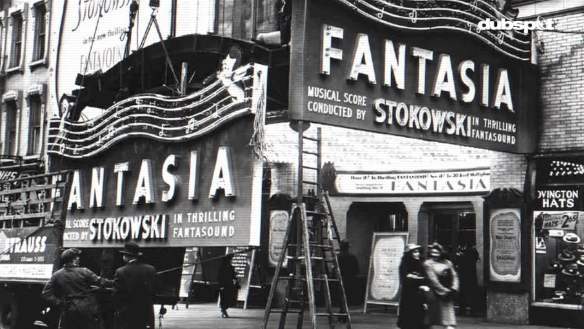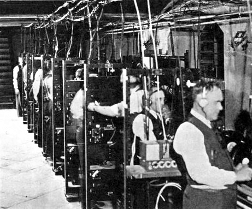

- © 2003 - 2025 Dynamix Productions, Inc. Contact Us 0



Mickey Mouse: Mr. Stokowski. Mr. Stokowski! Ha! My congratulations, sir.
Leopold Stokowski: Congratulations to you, Mickey.
Mickey Mouse: Gee, thanks. Well, so long. I'll be seein' ya!
Leopold Stokowski: Goodbye.
In 1940, before the world would be plunged into a half decade of devastating conflict, a larger-than-life cartoon creator teamed up with a wild-haired orchestra conductor and unleashed a fantastical film that would forever change the way we experience movies. The morning after the gala event at the Broadway Theater in New York City, The New York Times critic Bosley Crowther said,
"The music comes not simply from the screen, but from everywhere; it is as if a hearer were in the midst of the music."
Even with all the wondrous characters, vivid animation, and whimsical storytelling of this new film, it was the sound that stole the show.
Fantasia from Walt Disney Productions has delighted audiences for years, been resurrected from imminent decay several times, and overcome its initial box-office failure. The animated feature's soundtrack featured the Philadelphia Orchestra playing eight orchestral pieces (one with a vocalist) from composers such as Stravinsky, Bach, Beethoven, and Tchaikovsky, and conducted by the world-famous Leopold Stokowski. There were many rules that Walt Disney broke when he dreamed up the film: it's length (125 minutes, the longest ever animated Disney feature), it was a full-length animated musical (called a "long-haired musical" by RKO Radio Pictures), the cost of producing the soundtrack ($400K, or 17% of the film's budget), and the expensive sound playback equipment ($85K per theater, $1.7MM today).
Fantasia was the first commercially released stereo / multichannel audio film. But the most groundbreaking part of the film was how the soundtrack was played back in theaters. Fantasia's soundtrack was at its heart stereo, but it wasn't just played back through two speakers behind the screen. It had a third recorded channel that helped to immerse the audience "into the orchestra." Dubbed "Fantasound" by Disney, engineers had installed 96 speakers throughout the theater that surrounded the audience. This wasn't lost on Crowther:
"As the music sweeps to a climax, it froths over the proscenium arch, boils into the rear of the theatre, all but prances up and down the aisles.”
This was literally the earliest beginnings of surround sound, and it was waaaaay ahead of its time. It would be years before films were routinely released in stereo, and decades before surround sound became the norm. For Fantasia's Fantasound, separate rear speakers independently played back a third recorded channel. It was manually turned on and off during screenings for effect. What was in this third channel? Soloists and a distantly placed microphone of the orchestral recordings that gave more realism to the sound. Today we call it a "room mic" which adds natural depth to drum and ensemble recordings.
Only 12 theaters ever played the film with Fantasound (and all 15,000 pounds of its equipment), so those that experienced these early Fantasia screenings as it was intended were very fortunate. At first, Walt Disney was so enthralled with the film that he wanted to put new music segments in every year and rerelease it over and over again as a "new" film. But World War II killed the movie, the profits, and his dreams.

Leopold Stokowski was the person most responsible for the film's technological breakthroughs in sound. By 1939, the conductor had already reached "rock star" status. When Disney first met Stokowski in Los Angeles, someone described the history-making encounter as "maestro meets mouse-tro." Disney was interested in pushing the technology envelope in his films, and Stokowski was already doing that with sound recording. In 1931 and 1932 he had recorded the Philadelphia Orchestra (of which he was the conductor) in the first orchestral stereo recordings. Working with both Bell Labs and RCA (Disney's partner) throughout the 1930s, they did numerous recording experiments, mostly in Philadelphia's Academy of Music opera hall. This is also where the soundtrack for Fantasia was recorded.
In 1933, the seeds of Fantasound were planted when the Philadelphia Orchestra's performance at the Academy of Music was transmitted via telephone lines to Washington, D.C. There, Stokowski manned the audio controls and mixed three channels of sound over separate speakers to a live audience. In 1937 he recorded the soundtrack for the film One Hundred Men and a Girl in stereo, though the picture was released in mono (he also played himself in the film). By the time he met with Disney, he was fully vested in multichannel sound and film.

Fantasia recording.
Recording the soundtrack was almost as groundbreaking as playing it back. Over 7 weeks and 42 recording sessions, 33 microphones were spread around the opera house, most of which were specifically placed within the orchestra for more detail from each section. But instead of engineers mixing these multiple microphones down to one recorder "live" and in real time, 8 groups of microphones were recorded onto 8 separate optical film recorders – all synchronized together (see picture). Recording onto optical film was one of the highest-quality ways to capture sound at the time, and Fantasia used more than 90 miles of it. Using optical film was crucial to not only maintain synchronization between tracks, but to the final film itself. Something else they did that is commonplace today was to overdub soloists in another studio in Los Angeles. Overdubbing is a mainstay in recording today, but in 1939 it was a new concept. So was the click track, a separate channel that contained a recording of a metronome
To mix the soundtrack, audio engineers blended the eight separate channels down to three and, using devices fashioned with gears and bicycle chain sprockets, playfully panned some of the instruments back-and-forth around the audience. Techniques and devices considered Audio 101 today were either created or invented just for this soundtrack.
Fantasia has lived on in many forms over the last 80 years. When RKO Radio Pictures released it to the general public in 1942, its length was cut to 80 minutes and the soundtrack was in mono. In the 1956 re-release, the stereo version was restored. The first soundtrack of Fantasia was released as a stereo LP set in 1957. Disney digitally re-recorded the soundtrack for the film's rerelease in 1985, which was the first film to be publicly shown with full digital sound. However, the original optical soundtrack in Fantasound was restored and recreated in digital surround for the 50th Anniversary release in 1990. The VHS and laserdisc versions had a similar, but less dramatic, surround version. In 1991 (and a 2001 rerelease) the soundtrack was released on CD and sold 100,000 copies in the first year alone. You can now find the original soundtrack on services such as iTunes and Spotify.
Before Fantasia, no film audience had ever experienced this kind of "surround" sound. It was a moment in cinema history not to be forgotten. And Bosley Crowther, in a 1940's kind of way, couldn't have said it better:
"Mr. Disney and his troop of little men, together with Leopold Stokowski and the Philadelphia Orchestra and a corps of sound engineers, have fashioned with music and colors and animated figures on a screen a creation so thoroughly delightful and exciting in its novelty that one's senses are captivated by it, one's imagination is deliciously inspired."
A wonderful and detailed article from WHYY in Philadelphia about the recording process, complete with pictures of artifacts from the actual recording can be found at https://whyy.org/articles/modern-movie-sound-was-born-in-a-philadelphia-basement/
And a contemporary article published in the August 1941 Journal of the Society of Motion Picture Engineers is at http://www.widescreenmuseum.com/sound/fantasound1.htm.